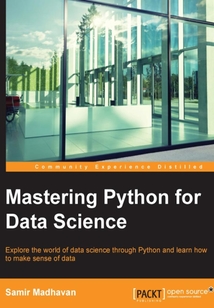目錄(103章)
倒序
- coverpage
- Mastering Python for Data Science
- Credits
- About the Author
- About the Reviewers
- www.PacktPub.com
- Support files eBooks discount offers and more
- Preface
- What this book covers
- What you need for this book
- Who this book is for
- Conventions
- Reader feedback
- Customer support
- Chapter 1. Getting Started with Raw Data
- The world of arrays with NumPy
- Empowering data analysis with pandas
- Data cleansing
- Data operations
- Summary
- Chapter 2. Inferential Statistics
- Various forms of distribution
- A z-score
- A p-value
- One-tailed and two-tailed tests
- Type 1 and Type 2 errors
- A confidence interval
- Correlation
- Z-test vs T-test
- The F distribution
- The chi-square distribution
- The chi-square test of independence
- ANOVA
- Summary
- Chapter 3. Finding a Needle in a Haystack
- What is data mining?
- Presenting an analysis
- Studying the Titanic
- Summary
- Chapter 4. Making Sense of Data through Advanced Visualization
- Controlling the line properties of a chart
- Creating multiple plots
- Playing with text
- Styling your plots
- Box plots
- Heatmaps
- Scatter plots with histograms
- A scatter plot matrix
- Area plots
- Bubble charts
- Hexagon bin plots
- Trellis plots
- A 3D plot of a surface
- Summary
- Chapter 5. Uncovering Machine Learning
- Different types of machine learning
- Decision trees
- Linear regression
- Logistic regression
- The naive Bayes classifier
- The k-means clustering
- Hierarchical clustering
- Summary
- Chapter 6. Performing Predictions with a Linear Regression
- Simple linear regression
- Multiple regression
- Training and testing a model
- Summary
- Chapter 7. Estimating the Likelihood of Events
- Logistic regression
- Summary
- Chapter 8. Generating Recommendations with Collaborative Filtering
- Recommendation data
- User-based collaborative filtering
- Item-based collaborative filtering
- Summary
- Chapter 9. Pushing Boundaries with Ensemble Models
- The census income dataset
- Decision trees
- Random forests
- Summary
- Chapter 10. Applying Segmentation with k-means Clustering
- The k-means algorithm and its working
- The k-means clustering with countries
- Clustering the countries
- Summary
- Chapter 11. Analyzing Unstructured Data with Text Mining
- Preprocessing data
- Creating a wordcloud
- Word and sentence tokenization
- Parts of speech tagging
- Stemming and lemmatization
- The Stanford Named Entity Recognizer
- Performing sentiment analysis on world leaders using Twitter
- Summary
- Chapter 12. Leveraging Python in the World of Big Data
- What is Hadoop?
- Python MapReduce
- File handling with Hadoopy
- Pig
- Python with Apache Spark
- Summary
- Index 更新時間:2021-07-16 20:14:41
推薦閱讀
- 精通Nginx(第2版)
- ClickHouse性能之巔:從架構(gòu)設計解讀性能之謎
- Learning PostgreSQL
- Leap Motion Development Essentials
- 深入淺出Spring Boot 2.x
- Linux網(wǎng)絡程序設計:基于龍芯平臺
- Access 2010數(shù)據(jù)庫基礎(chǔ)與應用項目式教程(第3版)
- Web全棧工程師的自我修養(yǎng)
- Java性能權(quán)威指南(第2版)
- Java Web程序設計任務教程
- Java程序設計
- Swift細致入門與最佳實踐
- 從零開始學C#
- Practical Game Design with Unity and Playmaker
- Web前端應用開發(fā)技術(shù)
- Python 3 數(shù)據(jù)分析與機器學習實戰(zhàn)
- Extending Unity with Editor Scripting
- Python Machine Learning Blueprints:Intuitive data projects you can relate to
- 零基礎(chǔ)學Scratch 3.0編程
- UML基礎(chǔ)與Rose建模實用教程(第三版)
- Selenium Essentials
- Android Application Programming with OpenCV 3
- Tableau數(shù)據(jù)可視化從入門到精通
- Python Machine Learning / Second Edition
- 微機原理與接口實驗指導
- Visual C++程序開發(fā)參考手冊
- 編程之美
- H5設計與運營(視頻指導版)
- 整理優(yōu)先:小改進,大回報,整潔代碼設計指南
- Node.js開發(fā)實戰(zhàn)


